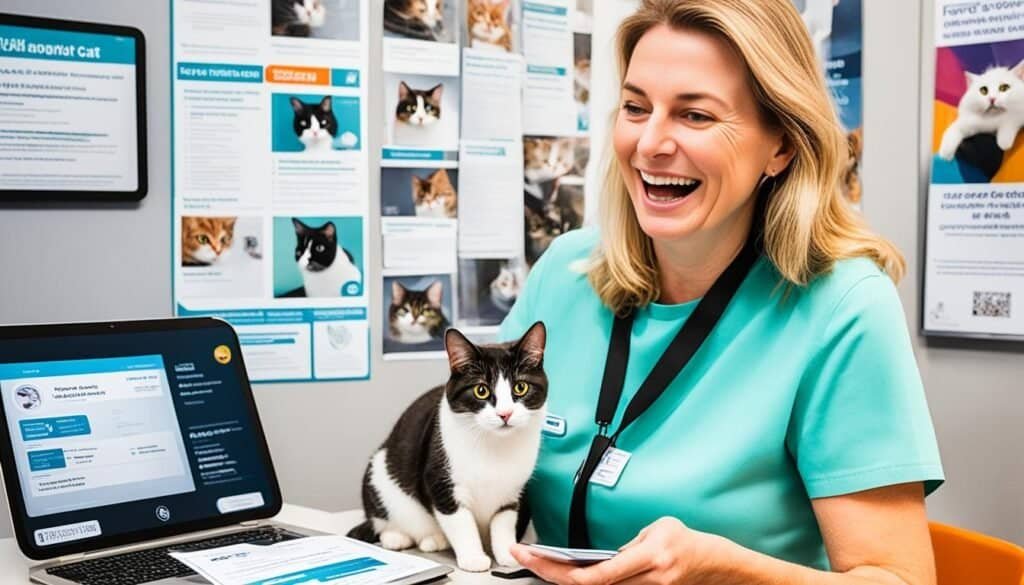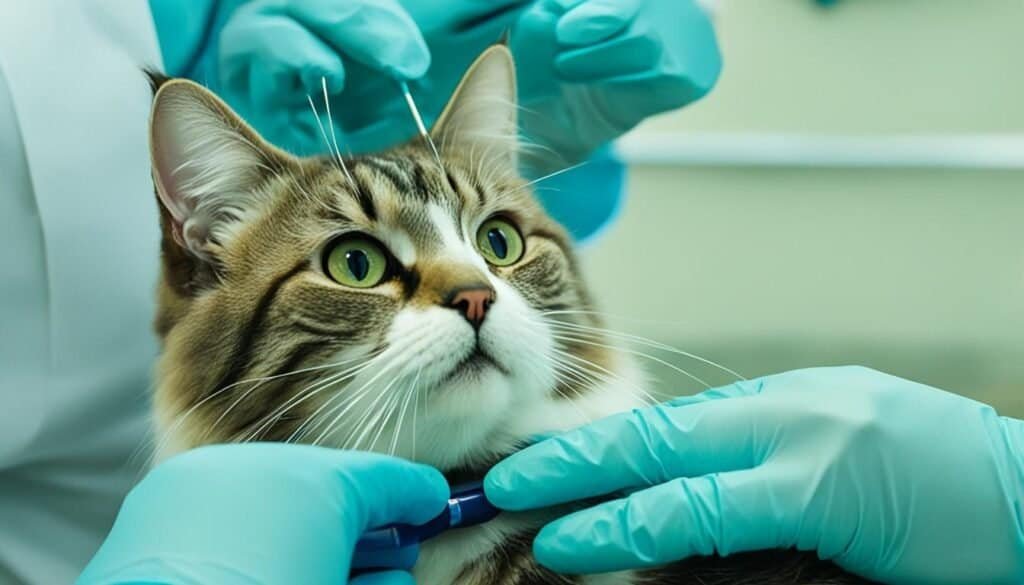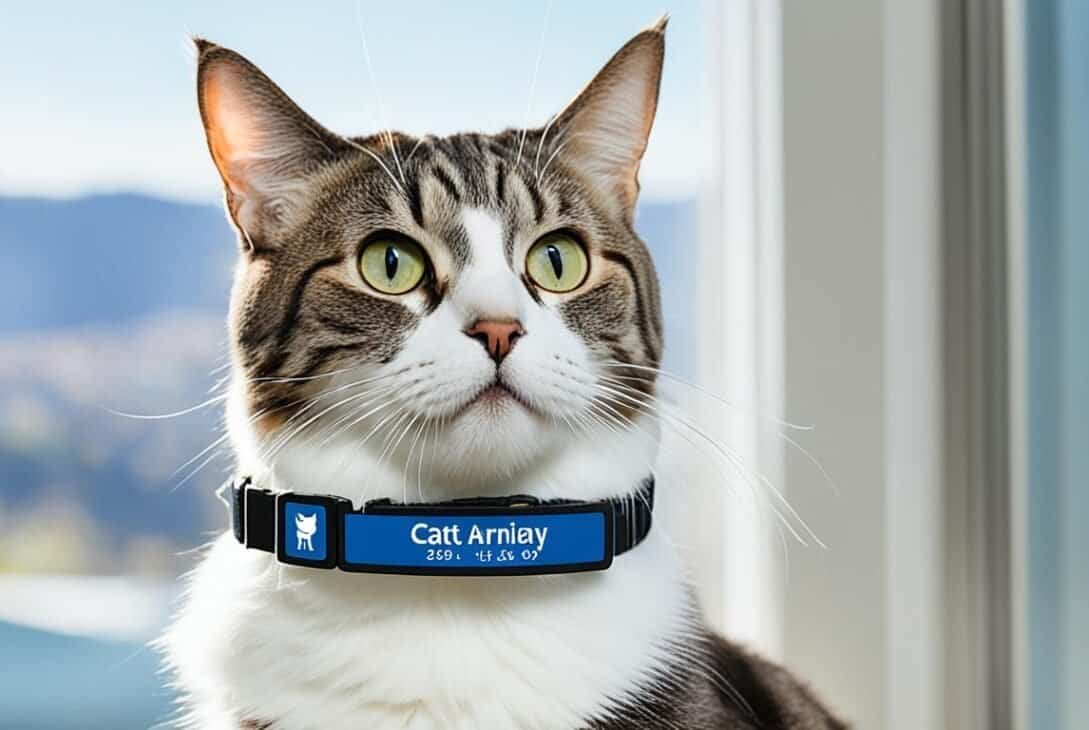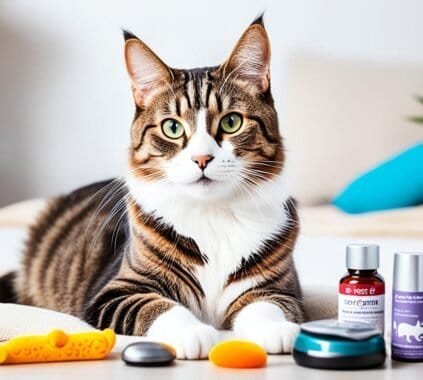Welcome to our comprehensive guide on cat identification and microchipping. As responsible pet owners, it is crucial to prioritize the safety and well-being of our beloved feline companions. One key aspect of ensuring their protection is through proper identification and microchipping. In this article, we will delve into the various methods, benefits, and processes involved in cat identification and microchipping to help you make informed decisions and keep your cat safe.
Key Takeaways:
- Cat identification and microchipping are essential for the safety and quick return of lost cats.
- Understanding different cat identification methods, such as collar tags and microchips, can help you choose the most appropriate option for your cat.
- Microchipping offers numerous benefits, including a reliable and permanent form of identification.
- Learn about the process of microchipping and why it is crucial to keep your contact information up to date.
- Ensure cat safety by implementing proper identification measures and taking preventive measures to minimize the risk of your cat wandering away.
Understanding Cat Identification Methods
When it comes to keeping our feline friends safe, cat identification methods play a crucial role. In this section, we will explore different options, such as cat collar tags and ID tags, to help you make an informed decision about permanent cat identification.
Cat collar tags are a popular choice for pet owners looking for a visible and easy-to-use identification method. These tags typically contain contact information, such as your phone number or address, making it easier for someone to return your lost cat if they find them.
However, it’s important to note that cat collar tags can get lost or damaged, reducing their effectiveness as a means of identification. Additionally, some cats may not tolerate wearing a collar, which can limit the usefulness of this method.
On the other hand, ID tags are another viable option for permanent cat identification. These tags are typically lightweight and can be securely attached to your cat’s collar or harness. They often have customizable features, allowing you to include essential details like your cat’s name, your contact information, and any relevant medical information.
When choosing between cat collar tags and ID tags, consider your cat’s comfort and personality. If your cat doesn’t mind wearing a collar, a cat collar tag can be a convenient choice. However, if your cat is more adventurous or tends to lose collars easily, an ID tag may be a better option.
Lastly, conducting thorough cat ID tag research is vital in finding the most suitable option for your furry companion. Look for tags that are durable, easy to read, and resistant to wear and tear. Check customer reviews and consider recommendations from other cat owners to ensure you invest in a reliable and effective cat identification method.
Key takeaways:
- Cat collar tags and ID tags are two common methods for permanent cat identification.
- Cat collar tags are visible and easy to use, but they can be lost or damaged.
- ID tags allow for customization and can be securely attached to collars or harnesses.
- Consider your cat’s comfort and personality when choosing between collar tags and ID tags.
- Conduct thorough cat ID tag research to find a durable and reliable option.
The Benefits of Cat Identification and Microchipping
Microchipping your cat can provide numerous benefits, ensuring permanent identification and increasing the chances of a lost cat being reunited with its owner. Microchipping technology has revolutionized the way we safeguard our furry friends, offering a reliable solution that goes beyond the limitations of traditional identification methods.
One of the main advantages of microchipping is its permanence. Unlike collars and tags that can be lost or removed, a microchip is implanted under the cat’s skin, providing a permanent identification that cannot be altered or tampered with. This makes microchipping particularly useful for outdoor cats or those prone to escaping, as it offers a reliable form of identification that stays with the cat at all times.
Microchips work by storing a unique identification number that is linked to the cat’s owner in a national pet registry. This means that if a lost cat is found, it can be scanned by a veterinarian or animal shelter to retrieve the owner’s contact information. This efficient system greatly increases the chances of a lost cat being reunited with its family, minimizing the stress and uncertainty that comes with a missing pet.
Microchipping technology has proven to be highly reliable, with studies showing a high rate of success in reuniting lost cats with their owners. According to the American Veterinary Medical Association (AVMA), approximately 52% of microchipped cats were returned to their homes, compared to only 22% of cats without microchips. This significant difference highlights the effectiveness of microchipping as a means of permanent identification.
Additionally, microchipping offers peace of mind for pet owners, knowing that they have taken proactive steps to ensure the safety and well-being of their cats. It provides a sense of security, knowing that even if a cat goes missing, there is a reliable method of identification in place that can aid in their safe return.
Overall, the benefits of microchipping are undeniable. It offers permanent cat identification, utilizes advanced technology, and significantly increases the chances of lost cats being reunited with their owners. By embracing microchipping, cat owners can provide their feline companions with the best possible protection and peace of mind.

The Process of Microchipping
Microchipping your cat is a simple and effective measure to ensure their safety and increase the chances of a lost cat being reunited with their owner. In this section, we will guide you through the process of microchipping and address any concerns or misconceptions you might have.

Microchipping technology involves the insertion of a small chip, about the size of a grain of rice, underneath your cat’s skin. Don’t worry—it’s a quick and painless procedure that can be performed by a veterinarian or a trained professional.
The Procedure
During the microchipping procedure, your cat will be gently restrained to keep them calm and comfortable. The area where the microchip will be inserted, typically between the shoulder blades, will be cleaned and sterilized.
Next, the microchip will be inserted using a sterile needle. Your cat may experience a slight pinch or discomfort, but it is generally well-tolerated. The entire procedure takes only a few seconds.
Once the microchip is in place, it will be tested to ensure it is functioning correctly. A handheld scanner is used to detect and read the unique identification number encoded in the microchip.
Addressing Concerns and Misconceptions
One common concern is that the microchip can be tracked or used to spy on your cat. Rest assured, microchips do not have any tracking capabilities, and they only provide identification information when scanned by authorized individuals or animal shelters.
Another misconception is that the microchip can cause health issues or adverse reactions in cats. The microchips used for pets are made of biocompatible materials that have been extensively tested for safety. It is highly unlikely for a cat to have any adverse reactions to the microchip.
It is crucial to keep your contact information associated with the microchip up to date. If you move or change your phone number, notify the microchip registry or the veterinarian who implanted the chip to ensure your cat can be easily identified and returned to you.
Microchipping your cat is a small but significant step in ensuring their safety. It provides peace of mind, knowing that if your cat ever goes missing, there is a higher chance of them being reunited with you. So, don’t delay—schedule an appointment with your veterinarian to get your cat microchipped today!
Ensuring Cat Safety with Microchipping
When it comes to the safety of your furry friend, microchipping plays a crucial role in preventing cats from getting lost. This permanent form of cat identification offers numerous benefits that can help ensure your cat’s well-being and provide peace of mind for you as a pet owner.
The Benefits of Microchipping
Microchipping provides a reliable and effective method of identifying cats, even if they lose their collar or tags. Unlike visible identification methods, such as collars or tags, microchips are implanted beneath the cat’s skin and cannot be tampered with or easily removed.
- Microchips help minimize the risk of your cat going missing and enhance the chances of a swift reunion if they do.
- The microchip contains a unique identification number, registered with a national pet recovery database, enabling shelters and veterinarians to scan the chip and retrieve your contact information.
- Microchipping is a one-time procedure, providing a lifetime of identification for your cat.
By ensuring your cat is microchipped, you significantly increase the chances of a happy reunion in the unfortunate event that your cat becomes lost.
Reducing the Risk of Lost Cats
In addition to microchipping, there are several steps you can take to reduce the risk of your cat wandering away from home:
- Keep your cat indoors or provide a secure outdoor enclosure to limit their opportunities to roam unsupervised.
- Ensure all windows and doors are secure, preventing your cat from accidentally escaping.
- Consider creating an enriching indoor environment with toys, scratching posts, and window perches to satisfy their natural instincts.
- Supervise outdoor time and use a secure harness and leash when taking your cat for walks.
- Spay or neuter your cat to reduce their desire to wander in search of a mate.
By combining microchipping with these preventative measures, you can significantly reduce the risk of your cat becoming lost and increase their overall safety.
Remember, microchipping is a simple, safe, and effective way to protect your beloved feline companion. By taking proactive steps to ensure their safety, you can enjoy peace of mind and create a secure environment for your cat to thrive.
The Importance of Pet Owner Responsibility
As a responsible pet owner, it is crucial to understand the importance of identification and microchipping for your cat. Microchipping provides numerous benefits that can greatly assist in reuniting lost or missing cats with their owners. However, it is not enough to simply microchip your cat.
One of the essential responsibilities of being a pet owner is to register your cat’s microchip. Registering the microchip ensures that your contact information is linked to the chip’s unique identification number, allowing shelters, veterinarians, and animal control professionals to contact you in the event that your cat is found.
When you register your pet’s microchip, it is crucial to keep your contact information up to date. This includes your current address, phone number, and email address. In the unfortunate event that your cat goes missing, having accurate and current contact information on file increases the chances of a successful reunion.
The Benefits of Pet Microchip Registration
Registering your cat’s microchip offers several advantages. First and foremost, it ensures that if your cat gets lost or wanders away from home, there is a higher likelihood of them being returned to you. Microchips are a permanent form of identification, unlike collars that can be lost or removed.
In addition, having your cat’s microchip registered and contact information up to date can save valuable time during the search and retrieval process. Shelters, veterinary clinics, and animal control agencies routinely scan lost animals for microchips. If your cat’s microchip is registered, the staff can quickly access your contact details and contact you promptly.
By registering your cat’s microchip and keeping your contact information current, you demonstrate your commitment to being a responsible and caring pet owner. It shows that you prioritize your cat’s safety and well-being and are willing to take the necessary steps to ensure their swift return in the event that they go missing.
As part of your pet owner responsibility, take the time to register your cat’s microchip and regularly update your contact information. This simple act can make all the difference in reuniting with your beloved feline companion if they ever become lost.
Researching Cat Identification Options
When it comes to cat identification, conducting thorough research is crucial to making informed decisions. Whether you are considering cat collar tags or ID tags, it is important to explore the available options before making a choice.
One of the first factors to consider is the durability and quality of the tags. Look for materials that are durable enough to withstand your cat’s daily activities and outdoor adventures. Metal tags, such as stainless steel or brass, are often recommended for their longevity.
Another important consideration is the readability of the tags. Ensure that the text on the tags is clear and easy to read, especially if you include your contact information. This will help others quickly identify your cat and contact you in case they get lost.
Additionally, consider the size and weight of the tags. You want to choose tags that are lightweight and comfortable for your cat to wear. Avoid tags that are too bulky or heavy, as they may cause discomfort or pose a risk of getting caught on objects.
When researching cat identification options, it can be helpful to read reviews and seek recommendations from other cat owners. Hearing about their experiences with different tags can provide valuable insights and help you narrow down your choices.
Once you have gathered sufficient information, make a list of the top contenders and compare their features, prices, and customer reviews. This will help you make a well-informed decision that suits your cat’s needs and your preferences.
Remember, cat identification is an essential aspect of responsible pet ownership. By taking the time to research and choose the right cat collar tags or ID tags, you can ensure that your furry friend has the best chance of being quickly reunited with you should they ever become lost.
Conclusion
In conclusion, cat identification and microchipping play a crucial role in ensuring the safety and swift return of lost cats. By understanding different identification methods such as collar tags and ID tags, cat owners can choose the most suitable option for their feline companions. However, microchipping offers numerous benefits, providing a permanent form of identification that cannot be lost or removed.
Microchipping is a quick and painless procedure that uses advanced technology to implant a small chip under a cat’s skin. This chip contains a unique identification number that is registered to the owner’s contact information. In the event that a cat goes missing, a veterinarian or animal shelter can scan the microchip and reunite the cat with its owner.
It is important for cat owners to take responsibility for the proper registration and maintenance of their pet’s microchip. Keeping contact information up to date is crucial to ensure a swift reunion if a cat is lost. Additionally, incorporating other safety measures such as keeping cats indoors and providing appropriate identification on collars can further reduce the risk of them getting lost.
By prioritizing cat identification and microchipping, cat owners can have peace of mind knowing that their beloved pets are protected. Remember, taking proactive steps to ensure the safety of your feline companions is key to providing them with a happy and secure life.
FAQ
Why is cat identification important?
What are the different cat identification methods available?
What are the benefits of microchipping?
How does microchipping work?
What is the process of microchipping?
How does microchipping prevent lost cats?
What responsibilities come with cat ownership in regards to identification and microchipping?
How can I research cat identification options?
Last modified: March 13, 2024













